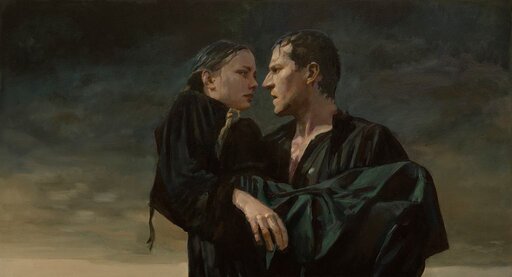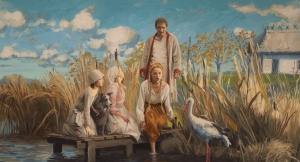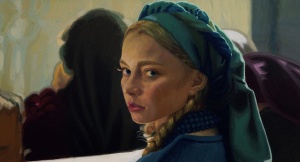
Digitalkraft is a pioneer studio among Serbian visual effects with a reputation for delivering projects for the US advertising and entertainment market, as well as regional TV series. The ambition of the studio’s VFX and post-production services was successfully expanded into co-producing English-language genre films and awarded animation shorts. Stepping out into a full-length animation is a breakthrough for the studio, but also a wider creative community. We spoke with their team about the last successful co-production – painted animation feature The Peasants, which gained affection of the world audience and promised to leave an indelible mark on the cinema world.
What aspects of the film’s production do you consider particularly triumphant or rewarding?
DK Team: The Serbian school of painting maintains and produces exceptional painters, in contrast to art programmes in other European countries that place a greater emphasis on modern technology. The opportunity for painters to thrive in a project like this, overcoming market challenges, brings immense joy. Securing early partnerships and navigating the project’s 200,000 hours of painting and 40,000 oil paintings is a testament to our team’s success.
 Can you elaborate on the collaboration between the filmmakers and the painters artists, and how their individual styles were integrated into the overall visual narrative?
Can you elaborate on the collaboration between the filmmakers and the painters artists, and how their individual styles were integrated into the overall visual narrative?
DK Team: The Peasants began as a live-action movie, with footage edited before distribution to painters. The painting supervisors created the so-called keyframes for the most significant shots. Painters across studios in Poland, Lithuania, Serbia, and Ukraine adhered to the style within a preset keyframe. This illustrated the main challenge, which is to harmonise the academic realism-based painting technique. A cohesive piece of film is ultimately produced by bringing together the complex emotional and mental states of the characters by multiple artists.
Creating an entire feature film with painted frames is undoubtedly a massive undertaking for any studio. What were some of the most significant decisions you made during the production, both technically and artistically?
DK Team: Crafting a feature film with painted frames is a monumental task. Pre-production involved a competitive call, in association with Serbian art faculties, which resulted in selecting 25 painters from 300 applications. The subsequent three years required deft supervision and synchronisation. Daily, a significant amount of painted frames were delivered to the Polish production. As a result, team leaders and painters had to collaborate diligently, interact with a lot of material and apply comments and requested modifications. Working without a reliable technical structure would be impossible. Each of the painters worked in a separate Painting Animation Working Station which contains equipment for live image projection and oil painting. On top of that, Digitalkraft produced the lively movie’s setting, using the Unreal Engine, as the actors were originally shot on the green screen.
 The underpinned artistic value of “The Peasants” is that it reflects styles in both the literature and paintings of the era. The cultural landscape of all co-production countries (Poland, Lithuania, Ukraine, Serbia) must have contributed to it with their art heritage. What were the key thematic elements that brought you as producers closer to the final cinematic narrative?
The underpinned artistic value of “The Peasants” is that it reflects styles in both the literature and paintings of the era. The cultural landscape of all co-production countries (Poland, Lithuania, Ukraine, Serbia) must have contributed to it with their art heritage. What were the key thematic elements that brought you as producers closer to the final cinematic narrative?
DK Team: The film brought together the Slavic countries, marked by a deep sense of tradition in rural life and artistic portrayals of cultural heritage and shared impulses in this part of Europe. Realism in these countries portrayed the often difficult position of people in the countryside in coexistence with nature. Polish painters drew inspiration from luminaries like Józef Marian Chełmoński, Leon Jan Wyczółkowski, and Jan Stanisławski, while Serbian counterparts found references in the works of Uroš Predić, Paja Jovanović, Milan Popović, and Miloš Tenković. These diverse influences converged to shape a cinematic narrative rooted in shared impulses and cultural richness.
Do you feel encouraged to take on more feature-length projects?
DK Team: Prior to and throughout working on the Peasants, Digitalkraft ventured out from image post-production to include the development and production of animated, feature, and documentary films. We co-produced the feature fiction “Suddenly” by Melisa Onel, which made its debut at the Tokyo FF (2022). The feature fiction “Daughter” by Vladimir Blaževski is in the additional financing stage, while Staša Bajac’s short fiction “Morocco” is in the phase of post-production. We got the support of the Film Centre Serbia for every project we have worked on thus far and certainly, this inspires us to carry on with our feature-length film production work.
 Would you agree that there is a higher thematic arc with Jagna and Barbie emerging on the cinema screen in the same year?
Would you agree that there is a higher thematic arc with Jagna and Barbie emerging on the cinema screen in the same year?
DK Team: Since Barbie’s introduction, there has been plenty of discourse about her, it is one of the most intricate cultural phenomena, and we may add to Jagna that she is one form of Slav Barbie in that variety of interpretations. To put it briefly, we believe that Jagna and Barbie are both more like reflections of ourselves within specific historical contexts.